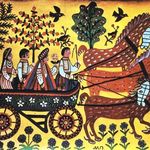Wedding is one of the most significant events for each person, and especially for a girl. Ukrainian wedding, however, is also the most dramatic event which fully reflects Ukrainian traditions, culture and folkways that have been accumulated across the generations, and now are gaining increasing popularity.
In ancient times, Ukrainian wedding was not only a way to conclude marriage. It was a very colorful ceremony involving a lot of people, various entertainments, and even required some acting talents. It was the entire theatrical performance
lasting for 2-3 days. The weddings were traditionally celebrated in autumn, right after the end of the field works, but before October 14 (
Feast of the Intercession of the Holy Virgin (Pokrov)). It has been well said:
“The Pokrov is coming, the girl starts whining.” That meant, the girl who did not manage to get married before the feast had the chance to get a husband not earlier than the next autumn. Nowadays, however, the wedding peak is in summer and early autumn.
The very wedding procedure consisted of several parts. For instance, first of all
Betrothing (Engagement) took place. Sometimes it were parents who made the deal based on their economic judgments, but most frequently the young couple made the decision themselves, and then told their parents about it.
The young man visited the girl’s parents in order to arrange the proper time for matchmaking. If the girl’s parents were against it, they refused or set forth conditions under which they would agree to bestow their daughter in marriage.
Matchmaking
The next stage was
matchmaking. The young man asked the most respected people in the village to be his matchmakers, and together they headed for the girl’s house. The matchmakers knocked the door three times, entered, and then asked the parents to give the “Pretty Marten” to their “Prince Hunter”. During that scene, the girl had to demonstrate embarrassment.
If the bride’s parents were willing to let their daughter’s marriage, they exchanged the matchmakers’ bread, tied them with embroidered towels, and the groom with a kerchief, and then wined and dined everyone. If previous agreements with a young man were made improperly, or if the girl’s parents changed their mind, they refused the matchmakers.
In case of refusal the matchmakers were given some vodka. Sometimes the parents could present to the matchmakers the conditions under which they would agree to marriage. In this case, the young man could fulfill their demands, come for matchmaking for the second time and get the deal accomplished. The second way to refuse the matchmakers was
a pumpkin. If the young man received a pumpkin, he could no longer pop the question. That is how a girl could ruin the matchmaking against her parents’ will if she did not like the candidate selected by them.
A detailed description of this very moment is provided in the comedy of Ukrainian writer H. Kvitka-Osnovianenko “
Matchmaking at Honcharivka” and the 1958 film of the same name.
Invitation
During the
invitation ceremony, the bride with the bridesmaids, or the bridegroom with the best men were walking through the village and inviting friends and relatives to the wedding. On entering the house, the bride or the bridegroom made a bow to the hosts and said: “My father invited, my mother invited, and I invite you to my wedding”. The hosts kissed the bride or the bridegroom on the head, promised to come to the feast, and wished them happiness.
Preparation for the wedding
Preparation for the wedding was a very long procedure. The family of the fiancée prepared dowry, cleaned the house and the yard, cooked the food – up to 20 dishes. Baking the wedding loaf was one of most remarkable traditions. For this specific purpose, the 3 – 7
loaf-bakers were invited. This role was assigned to happily married young women only. In the evening before the wedding, the bride had to say good bye to her maidenhood. Her girlfriends were visiting her and singing songs about the maiden youth, the upcoming separation from the parents and the happy life after the marriage.
Wedding
The wedding was usually celebrated on Sunday. In the morning, the bride was being prepared for the marriage: her hair was taken out of braid (most often, it was done by her brother), and then the bridesmaids weaved ribbons and coins into her hair, put some garlic in it (as a protective amulet), put a wreath and the best clothes on her, in order to show what a treasure they have to give away to another family.
The wedding started in the houses of each of the young couple. When the bridegroom headed for the bride, he was stopped on his way (and not even once!) with the demands to pay for the bride, and he had to pay the symbolic amount of money or vodka. Such bargaining was also done in the bride’s yard since the bride’s family demanded payment as well. Even nowadays, such bargaining turns into complete performance which not only entertains the guests but also shows how the bridegroom evaluates his fortune.
When the bridegroom arrived, the young couple stepped on the embroidered towel, for their lives to be long and smooth, and their parents blessed them. The parents blessed the couple and repeated: “May the God bless, and I bless you for happiness, health and long life”. Having received the parents’ blessings, the couple headed for the church wedding service followed by the relatives and guests.
And then there come celebrations, traditions and congratulations – everything we have even nowadays. Even without noticing it, we are still following most of the longstanding Ukrainian traditions, although they are not always up-to-date. That is because it’s the essence of Ukrainian nation –
if we do something, we do it wholeheartedly!
If you noticed any mistake or inaccuracy select the text fragment and press Ctrl+Enter.











